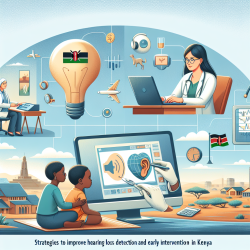In the context of global health, hearing loss is a significant issue, particularly in low- and middle-income countries (LMICs) like Kenya. According to the World Health Organization (WHO), approximately 34 million children globally suffer from disabling hearing loss, with the highest prevalence in LMICs. The recent research article "Hearing Loss Detection and Early Intervention Strategies in Kenya" highlights the importance of early identification and management of hearing loss, presenting a compelling case for practitioners to improve their skills and engage in further research.
Key Findings from the Research
The research underscores several critical points:
- Developing a national Ear and Hearing Care (EHC) program that includes support services for children with diagnosed hearing loss.
- Leveraging existing government and healthcare system policies for EHC programming.
- Strengthening connections between policymakers and local champions for the EHC agenda.
- Focusing on policy, early detection and intervention, habilitation, and family-centered care.
- Improving accessibility to services and equipment through updates to health policy and funding.
Strategies for Practitioners
To implement these findings effectively, practitioners can adopt several strategies:
1. Early Hearing Detection and Intervention
Adopting the Early Hearing Detection and Intervention (EHDI) 1-3-6 goals is crucial. These goals include:
- Initial hearing screen by 1 month of age.
- Diagnosis by 3 months for children who do not pass the initial screen.
- Enrollment in early intervention by 6 months for children diagnosed with hearing loss.
UNHS significantly lowers the average age at which a child is identified with hearing loss, maximizing language and communication competence, literacy development, and psychosocial well-being.
2. Habilitation and Family-Centered Care
Identification of children with hearing loss should be accompanied by management options. Individualized, family-centered guidance and resources improve support for parents and caregivers. Access to hearing technology and ongoing support from trained providers is essential.
3. Addressing Human Resource Gaps
LMICs often face human resource gaps in EHC. Training community health workers and other laypeople in certain EHC tasks can alleviate this scarcity. A "train the trainer" model has been successfully used in other countries to improve the stream of skilled providers.
Encouraging Further Research
While implementing these strategies is crucial, continuous research and data collection are equally important. Practitioners are encouraged to engage in further research to identify additional barriers and develop innovative solutions tailored to their specific contexts.
Conclusion
Untreated hearing loss can lead to disabling outcomes that are otherwise modifiable if treated early. Current challenges in Kenya include the lack of affordable and accessible screening and diagnostic equipment, limited EHC healthcare workers, and the absence of a well-supported EHC national program. However, strengths include partners ready to support EHC services, a passionate Technical Working Group, and a Ministry of Health prioritizing EHC programming.
To read the original research paper, please follow this link: Hearing Loss Detection and Early Intervention Strategies in Kenya.










